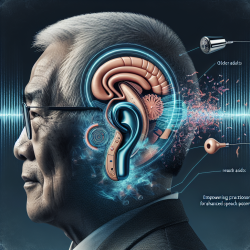Introduction
In the ever-evolving field of speech-language pathology, staying informed about the latest research is crucial for practitioners aiming to provide the best care for their patients. One such area of interest is Spinocerebellar Ataxia Type 34 (SCA-34), a rare neurodegenerative disorder that presents unique challenges in diagnosis and management. Recent research, including the article "Spinocerebellar ataxia-type 34: A case report and brief review of the literature," provides valuable insights into this condition, which can significantly enhance a practitioner's ability to make data-driven decisions.
Understanding SCA-34 and Its Diagnostic Challenges
SCA-34 is part of a group of over 40 genetic disorders characterized by progressive ataxia and dysarthria. The hallmark of SCA-34, as highlighted in the case report, is the presence of the "hot cross bun sign" (HCBS) on MRI imaging, a feature it shares with other neurodegenerative disorders like Multiple System Atrophy (MSA). This overlap in imaging can complicate diagnosis, underscoring the importance of genetic testing and a comprehensive clinical evaluation.
Key Findings from the Research
- The HCBS is not exclusive to MSA; it can also appear in SCA-34, necessitating careful differential diagnosis.
- Genetic testing revealing mutations in the ELOVL4 gene can confirm a diagnosis of SCA-34, distinguishing it from other conditions.
- The research emphasizes the role of multidisciplinary management, including physical, speech, and occupational therapies, in managing symptoms.
Implications for Practitioners
For practitioners, the findings of this research have several implications:
- Enhanced Diagnostic Accuracy: Understanding the nuances of MRI imaging and genetic markers can aid in more accurate diagnosis, preventing misdiagnosis and ensuring appropriate treatment.
- Comprehensive Care Plans: Incorporating a multidisciplinary approach, including regular speech therapy, can help manage symptoms and improve patient outcomes.
- Continued Research and Education: Practitioners are encouraged to stay updated on emerging research and consider participating in studies to further the understanding of SCA-34 and similar disorders.
Conclusion
The journey to effectively managing Spinocerebellar Ataxia Type 34 is complex, but with the right tools and knowledge, practitioners can make a significant difference in the lives of their patients. By leveraging the insights from the latest research, including the critical role of genetic testing and imaging, practitioners can refine their diagnostic skills and enhance their therapeutic strategies.
To read the original research paper, please follow this link: Spinocerebellar ataxia-type 34: A case report and brief review of the literature.










